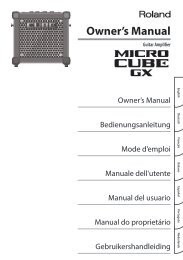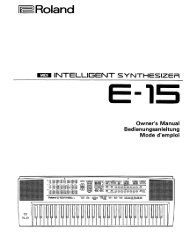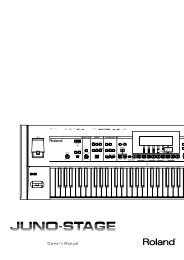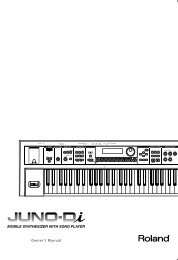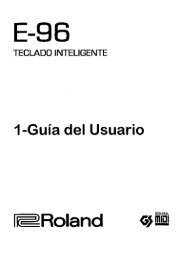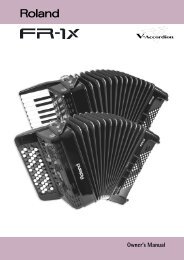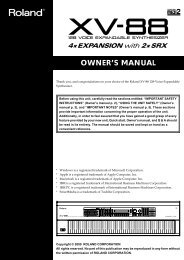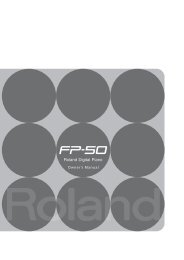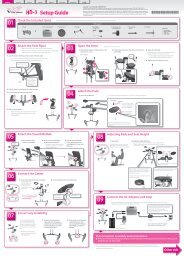Owner's Manual - Roland
Owner's Manual - Roland
Owner's Manual - Roland
You also want an ePaper? Increase the reach of your titles
YUMPU automatically turns print PDFs into web optimized ePapers that Google loves.
Creating a Patch<br />
Cutoff Frequency ★<br />
110<br />
Selects the frequency at which the filter begins to have an<br />
effect on the waveform’s frequency components.<br />
Value: 0–127<br />
With “LPF/LPF2/LPF3” selected for the Filter Type parameter,<br />
lower cutoff frequency settings reduce a tone’s upper<br />
harmonics for a more rounded, warmer sound. Higher<br />
settings make it sound brighter.<br />
If “BPF” is selected, harmonic components will change<br />
depending on the TVF Cutoff Frequency setting. This can be<br />
useful when creating distinctive sounds.<br />
With “HPF” selected, higher Cutoff Frequency settings will<br />
reduce lower harmonics to emphasize just the brighter<br />
components of the sound.<br />
With “PKG” selected, the harmonics to be emphasized will<br />
vary depending on Cutoff Frequency setting.<br />
Resonance ★<br />
fig.06-034.e<br />
To edit the overall patch while preserving the relative<br />
differences in the Cutoff Frequency values set for each<br />
tone, set the Cutoff Offset parameter (p. 98).<br />
Emphasizes the portion of the sound in the region of the<br />
cutoff frequency, adding character to the sound. Excessively<br />
high settings can produce oscillation, causing the sound to<br />
distort.<br />
Value: 0–127<br />
Level<br />
High<br />
parameter value<br />
Low<br />
To edit the overall patch while preserving the relative<br />
differences in the Resonance values set for each tone,<br />
set the Resonance Offset parameter (p. 98).<br />
LPF BPF HPF PKG<br />
Cutoff frequency<br />
Frequency<br />
Cutoff Keyfollow<br />
fig.06-035.e<br />
Use this parameter if you want the cutoff frequency to<br />
change according to the key that is pressed. Relative to the<br />
cutoff frequency at the C4 key (center C), positive (+) settings<br />
will cause the cutoff frequency to rise for notes higher than<br />
C4, and negative (-) settings will cause the cutoff frequency to<br />
fall for notes higher than C4. Larger settings will produce<br />
greater change.<br />
Value: -200, -190, -180, -170, -160, -150, -140, -130, -120,<br />
-110, -100, -90, -80, -70, -60, -50, -40, -30, -20, -10,<br />
0, +10, +20, +30, +40, +50, +60, +70, +80, +90,<br />
+100, +110, +120, +130, +140, +150, +160, +170,<br />
+180, +190, +200<br />
Cutoff V-Curve<br />
(Cutoff Frequency Velocity Curve)<br />
fig.06-036<br />
Cutoff frequency<br />
(Octave)<br />
+2<br />
+1<br />
o<br />
-1<br />
-2<br />
-200 -100<br />
C1 C2 C3 C4 C5 C6 C7 Key<br />
Selects one of the following seven curves that determine<br />
how keyboard playing dynamics (velocity) influence the<br />
cutoff frequency. Set this to “FIXED” if you don’t want the<br />
Cutoff frequency to be affected by the keyboard velocity.<br />
Value: FIXED, 1–7<br />
+200<br />
+100<br />
1 2 3 4 5 6 7<br />
+50<br />
0<br />
-50



